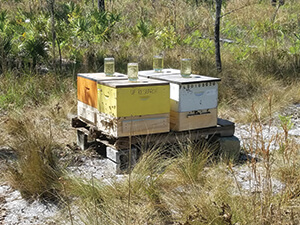
In the March 2022 issue of Notes from the Lab [162(3):325-327] I summarized a study from Marseille, France, which showed that when there were greater numbers of managed honey bees at a national park, native wild bees visited flowers from different plant species. One interpretation of the study is that honey bees outcompeted the wild bees for floral resources, resulting in less food for the wild bees.
Another interpretation could go something like this: There were plenty of flowers, the native wild bees simply switched to forage at other plant species when honey bees became abundant, and they continued to gather plenty of pollen and nectar for their needs. In other words, the impact of increased managed honey bees was small changes in native wild bee behavior, but without negative consequences.
It’s impossible to say with certainty which conclusion is correct — competition or no competition — based on the data gathered in the French study. But as more and more research is conducted on this topic, scientists are gathering better data, which is translating to better insight into when managed honey bees do in fact compete for resources with native wild bees.
In this month’s column, we’re going to head down to the pine savannas of Florida to continue addressing several questions about competition. Does introducing managed honey bees to a site alter native wild bee foraging rates at flowers? Are all wild bees affected similarly? And can competition occur when only four hives (i.e., a very modest apiary) are introduced to a site? These are the topics for the fifty-seventh Notes from the Lab, where I summarize “Effects of short-term managed honey bee deployment in a native ecosystem on wild bee foraging and plant–pollinator networks,” written by James Weaver and colleagues and published in Insect Conservation and Diversity [2022].
For their study, Weaver and colleagues deployed four honey bee colonies for six weeks at two pine savanna sites in Florida: the Austin Cary Memorial Forest (ACF) and Goethe State Forest (GSF). Each colony was comprised of a single hive body, and worker populations were assessed visually to ensure roughly equal-strength colonies across both ACF and GSF sites. This magnitude of honey bee pressure (i.e., four small colonies) is lower than would be experienced during most commercial beekeeping activities and therefore is meant to be a conservative manipulation of the pressure of managed honey bees on native wild bees.
The study was repeated four times: fall 2018, spring 2019, summer 2019, and fall 2019. No privately managed honey bee colonies were present within 3 km of either site for the duration of the experiments, meaning the only colonies present within the typical flight radius of bees were those introduced by the authors.
The short-term nature of managed colony additions meant the plants and pollinators were able to be surveyed before, during, and after the managed honey bees were introduced, thereby assessing how the pollinator community and plant-pollinator interactions changed. To do this, the authors sampled multiple 50 m2 observation plots immediately surrounding the apiary (0 m) and at 250 m, 500 m, 750 m, 1 km, and 1.25 km from the apiary at each site (Figure 1). At each plot, bees were observed visiting flowers for a standard amount of time based on flower density. All flowers were identified to the lowest taxonomic level possible in the field (typically species, but occasionally genus — see Figure 2). All bees were identified to species in the field, or to the lowest taxonomic level possible and a specimen was collected for later identification to species in the lab.
Overall, the authors conducted 468 plot samplings where honey bee colonies were present and 468 plot samplings where honey bee colonies were absent. They observed 393 honey bee and 1610 wild bee visits in total across all sites, treatments, and seasons. A very nice dataset.
So, what did they find? Did introducing managed honey bees impact plant-pollinator visitation networks? Yes and no. As seen in Figure 2, introducing honey bees caused more honey bees to visit flowers at the ACF site; compare the small red bar for honey bees on the right side of panel (a) to the larger red bar on the right side of panel (b). But the overall plant-pollinator interaction networks did not change significantly at either site. There also was not an increase in honey bee abundance at the GSF site, perhaps due to a greater abundance of feral hives at that site. Note: While the ACF forest has not had a history of commercial apiary presence, the GSF forest had at least 5+ years of apiary contract history, perhaps promoting the establishment of feral colonies in the forest.
What about visitation rate of native wild bees at flowers? Was that impacted by introducing managed honey bees? Yes, and here’s where the study by Weaver and colleagues really breaks ground. As seen in Figure 3, wild bees visited 19% fewer flowers per plot when managed honey bees were present compared to absent at both the ACF and GSF sites. This means wild bees were probably getting 19% fewer resources when managed honey bees were present compared to absent at the site. That’s 19% less food!
Well that’s troubling. Were all the wild bees impacted equally? No. Honey bees differed in their foraging preferences for plant species compared to small-bodied bees (Lasioglossum, Perdita, Augochlorella), specialist species (Perdita, Andrena), and Megachile. But their preferences overlapped with ….


